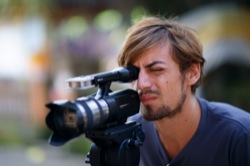
There is a lot of really great technology being used on budget cameras – unfortunately, not all on the same camera…
Whether you are using an HD DSLR or any of the many compact camcorders, it is possible to produce very nice looking pictures. It isn’t easy and broadcasters might flinch from the results because some aspect of your camera doesn’t meet their technical requirements for HD. However, the distance between the camera you have and the camera you need seems bridgeable. So, why isn’t it being bridged?
At HD Masters 2008, Andy Quested, principal technologist, BBC HD, stated that he essentially wanted a camcorder with the front end of a Sony EX1 and the back-end of a Panasonic HVX 200 (or similar), as the BBC didn’t believe that compact cameras with sensors of less than half an inch or inter-frame camera compression below 50Mbps were good enough for HD. Given that as the BBC goes, many others would follow, you’d think manufacturers would have rushed to produce something with exactly those specifications.
After all, there are an awful lot of Sony Z1 HDV camcorders out there (which were used to shoot observational documentaries and more in standard definition), and production companies are crying out for an HD replacement.
For that market, size is critical, as is ease of use. Price is also an issue, but less critical than you might think if the technology is right. However, manufacturers would prefer that broadcast users would buy their larger, more expensive models, which are not what productions need.
At the moment, the closest to the ideal seems to be the new Canon XF300 and XF305 camcorders, which are the most affordable cameras on the BBC’s latest list of approved cameras for HD production – although they are only permitted for use by independent productions. The XF300 costs less than £6,000, while the XF305 adds HD-SDI output, Genlock input and Time code i/o for about 10% extra. The other cameras on the approved list cost at least three or four times more.
The XF models are Canon’s first Full HD MPEG-2 4:2:2 50Mbps camcorders (meeting one of Quested’s parameters). They record MXF files to Compact Flash cards, and are highly compatible with broadcast post production. Most rival cameras record 4:2:0.
However, behind their 18x L-series HD lenses, the cameras have three 1/3-inch CMOS sensors. Although they are claimed to offer “exceptional colour accuracy, wide dynamic range and low noise” and use high-speed data readout (2x speed) to minimise the rolling shutter skew common to most CMOS camcorders, the sensor size isn’t ideal.
The cameras also offer slow and fast motion recording, with 20 speeds to choose from in 720p mode and nine in 1080p (normal recording speeds are 1080 50i or 25p, 720 50/25p (in the European versions).
Sensor sensibility
What many productions would like are larger sensors. Much larger. Conventional broadcast cameras tend to use three 2/3-inch sensors, but HD DSLRs usually use a single APS-C sensor (some 5.5 times larger and roughly the size of a 35mm movie frame). This gives very shallow depth of field and permits the use of a wide range of excellent lenses that are often relatively inexpensive (by video standards). Some DSLRs can also be fitted with PL-mount cine lenses.
The results can be excellent. However, there are lots of compromises to be made. The latest slew of HD DSLRs from Sony, Nikon and Canon suffer from a range of “features” that can frustrate anyone trying to use them for serious video production.
The recording bitrate on HD DLSRs and budget camcorders is almost invariably too low. The Canon 550D/60D/7D trio are about the best of the bunch, recording at 44Mbps, but Sony’s DSLRs record AVCHD at just 17Mbps (despite the fact that the AVCHD standard goes up to 24Mbps). Nikon hasn’t revealed official figures for its new D3100, but our testing showed about 20Mbps on a pre-production model. At the very least both should have aimed for 24Mbps.
Panasonic’s micro-four thirds cameras are similarly constrained – despite the fact that its consumer camcorder division makes a little three CMOS camcorder, the SD700, that records AVCHD at 28Mbps (at 50/60p).
Both Panasonic and Sony also seem to have settled on AVCHD at 24Mbps for their compact professional camcorders, such as Sony’s NXCAM or its upcoming DSLR-based Handycam NEX-VG10E. When Panasonic first showed a mock-up of its forthcoming 3D camcorder it had an AVC-Ultra logo (which would have meant recording up to 200Mbps), although AVC-Intra (at 100Mbps) would have been more than acceptable. Instead, the AG-3DA1 records 24Mbps AVCHD when even its consumer Mini-Me version (the new SD700-based HDC-SDT750) records at 28Mbps…
Bitrate hacked
The improvement a higher bitrate can make is easily seen on Panasonic’s GH1 camera. It has been hacked to record at higher bitrates.
Andrew Reid of eoshd.com shot a test on the GH1 at ISO 1600 using both 1080/24p AVCHD at 44Mbps and 720/30p MJPEG at 70Mbps – both show a considerable improvement over the standard 17Mbps, although the AVCHD is a clear winner. Watch the video on Vimeo.
Of course, HD DSLRs have other hurdles to overcome, not least aliasing and moiré patterns, which are evident on Reid’s video. Panasonic promises to address this problem with its new AG-AF101 camcorder, which is based on the Micro Four Thirds sensor and lens system used by the GH1. However, the AG-AF101 is also limited to AVCHD 24Mbps 4:2:0. It also appears that Panasonic may have taken action to prevent the hack working on the most recent shipments of the GH1, so the AF101 may not be hackable either. Perhaps Panasonic should offer its own 44Mbps version at a reasonable mark up.
The NEX-VG10E and AG-AF101 are just the first of several DSLR-inspired cameras coming over the next few months, and hopefully will inspire the likes of Nikon and Canon to respond with more video-friendly features, such as peaking and zebras to aid focusing and exposure, anti-aliasing, better audio controls, those higher bitrates or, at least, HDMI interfaces that allow non-compressed video to be recorded in a nanoFlash or similar higher bitrate recorder. CMOS sensors with less pronounced rolling shutter defects would be nice too.
Despite the problems, the artistic possibilities of HD DSLRs and their ilk can make all the hassle worthwhile. Canon’s 5D Mark II, with its even larger full-frame 35mm sensor, was used to shoot the finale of last season’s run of House. It had a noticeably different look to the standard film production, but worked well for what they wanted it to do. For the upcoming season of House the 5D will be used routinely on episodes, especially when they want a more intimate look. This certainly proves that the rapid adoption of HD DSLRs has not just been for cost reasons. It certainly hasn’t been for ease of use….







